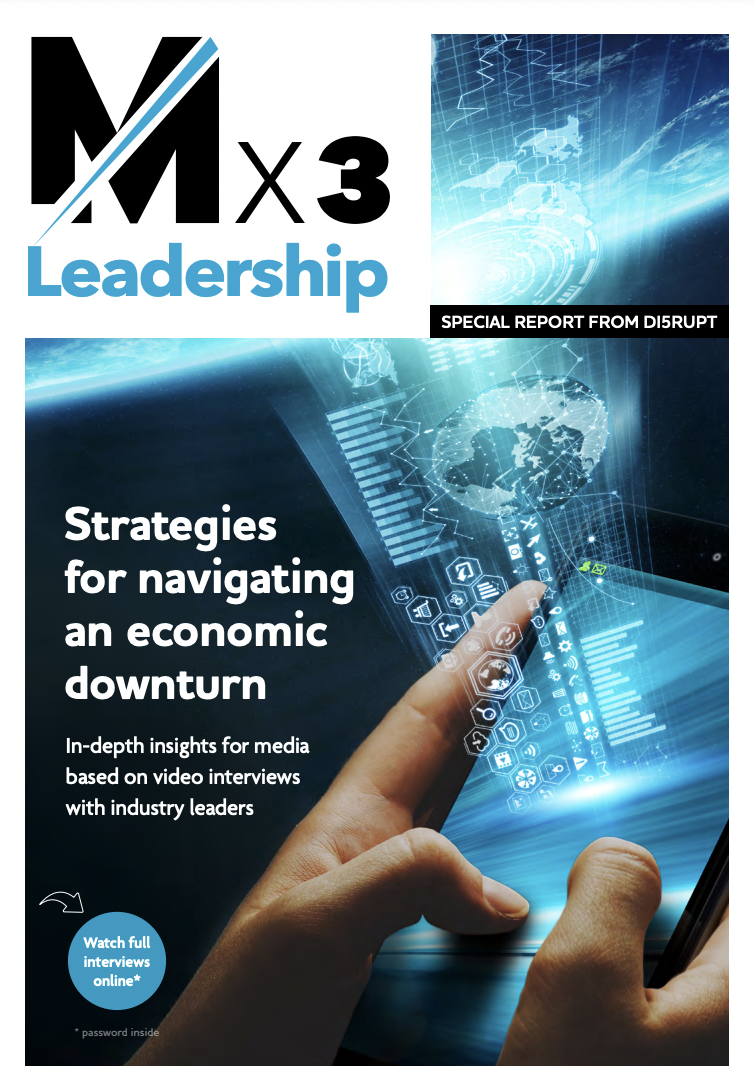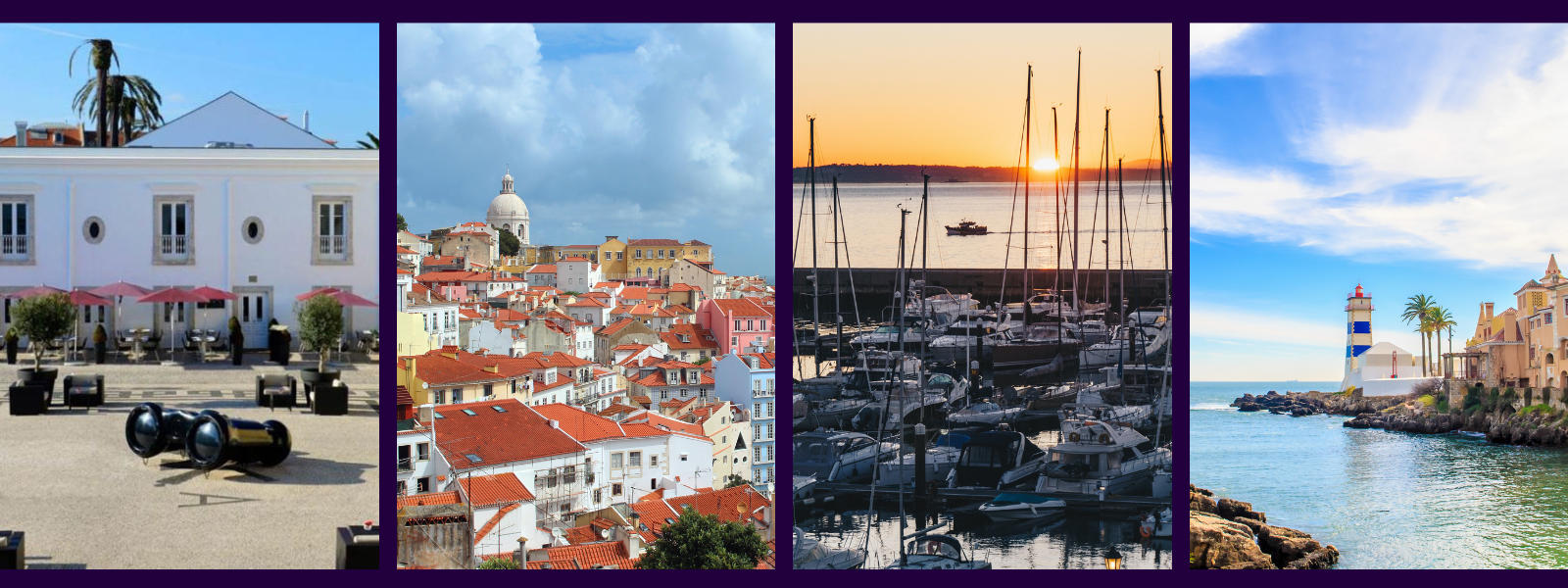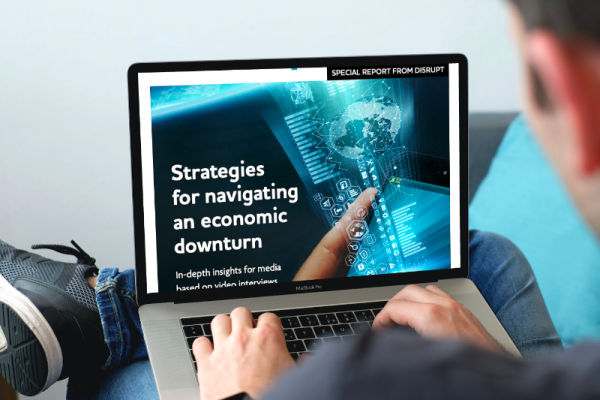Strategies for navigating an economic downturn – special report
Besides a few markets in the world, 2023 will be a year where the media industry must navigate an economic downturn against geopolitical uncertainty in regions like Europe.
Cutting to survive may seem the most plausible strategy at times like this, but it can inflict irreparable harm on brands. Instead, as Sarah McConville, EVP and Group Publisher of Harvard Business Review, puts it below, “We saw a flight to quality in the last downturn, and we see that happening again.” (Read the full interview with her below).
Today, Di5rupt is launching a free Mx3 (Media Makers Meet) Leadership report with strategies for navigating an economic downturn following interviews with several business leaders in the media and media-tech sectors. The objective is to provide thoughts on how media businesses can best navigate the downturn.
Download the full report here. It’s free.
The report includes a quick list with the main do’s and don’ts identified and the link and password to a library with video recordings of interviews should you want to watch more of what a particular person had to say.

To provide a taster of what is in the report, here is the conversation we had via email with Sarah about HBR’s strategies during the downturn.
How is HBR approaching the economic downturn?
Like many media brands, we’re watching the market carefully. HBR plays a vital role in publishing content for leaders who need trusted guidance in all sorts of market conditions – including downturns and recessions. Recently, we’ve published articles on investing through a downturn to emerge stronger, managing teams under stress, responding to polarisation in the workplace, and how to navigate economic and geopolitical threats. We serve our audience with insights beyond what they get from news outlets.

As a business, we practice what we publish, prioritising delivering the greatest value for our readers and subscribers. We dedicate resources to innovating new formats and leveraging technology to enhance the customer experience. We continue to focus on quality content. We’re bringing new formats to market, such as the recent launch of digital learning pathways in leadership and management as part of an HBR subscription. We’re reaching early-career professionals with HBR Ascend, which publishes across social media channels, on HBR.org, and in newsletter format, that focuses on the challenges of gaining experience and making myriad decisions about your career while being new to the workforce.
We publish content that’s relevant today, while focusing on the long-term as a business. That means continuing to innovate while remaining focused on subscriber engagement and retention and publishing content that attracts new audiences to the HBR brand.
What are your key strategies for building a resilient, adaptable digital media brand?
For HBR, it starts with the content – publishing indispensable ideas and guidance for established and aspiring leaders worldwide.
We publish across multiple formats – on HBR.org, across social platforms, where our collective reach is 28M, in video, audio, and via our podcast network. This creates many points of entry into HBR, many opportunities to discover our contributors and us, and serves our audience however they want to consume our content.
We publish along a spectrum of timely to timeless. We can deliver a powerful combination of articles that are incredibly relevant in the moment, but also leverage the richness of the HBR content archive to help readers with ideas and solutions to challenges they may be facing at any point in their careers.
With an expected rise in advertising pullback, there is an increasing focus on diversifying revenue. How can you adjust your revenue strategy at a time like this?
HBR has always had a subscription-first revenue model. We offer digital-only, print-and-digital, and premium-tier subscriptions. While digital-only has been growing since we first offered it in 2019, the print magazine continues to be a strong driver of new subscriptions and renewal. So, while other media brands underwent a pivot from advertising to subscriber and print to digital, HBR has always followed the subscriber model while sustaining a print product of high value.
That said, our advertising business is also strong. Our value proposition to advertisers is delivering direct access to influential, key decision-makers in business across multiple industries. These professionals are incredibly selective with their time and attention and choose to spend that valuable resource with HBR.
We stay very close to our advertisers. Brands tend to have a long-term association with HBR. Our direct relationships with CMOs and media strategists often extend back several years. They want to know what we’re hearing from readers, what’s top of mind for global business leaders. We serve as strategic partners to our clients, helping them to align their messaging and brand priorities with what our audience is consuming.
We continue to innovate with offerings in our sponsor content portfolio. One of the fastest-growing areas of our advertising business is HBR Analytic Services, which is the commercial research arm of HBR.
We work with clients to research trending business topics, tapping into our 10,000-member HBR Advisory Council. We publish the findings in various formats, from white papers to pulse surveys and, more recently, as live events, which allow sponsors to contribute their perspectives on the research.
How do you think about pricing at a time like this?
HBR has always been premium-priced as a subscription and on the newsstand, where a single issue is US $19.95. In international markets, wherever we can, we use local currency for pricing, using the latest exchange rates to set a price that reflects the intrinsic value of HBR as a premium product.
We offer three tiers of subscriptions, with pricing parity for the all-access digital subscription and the all-access print + digital subscription, and a higher price for the premium tier that includes additional benefits such as curated Harvard Business School case studies. We will be testing higher-priced subscription tiers with the addition of the new learning pathways benefit.
What opportunities, if any, do you see arising from the current climate?
Going back to the first answer, HBR is focused on being indispensable to our audience at a time when trusted ideas and guidance are critical. We saw a flight to quality in the last downturn, and we see that happening again. Our job is to continue delivering relevant content that engages and retains our subscribers.
We continue to experiment with formats and new approaches to content. Our company’s product incubator is exploring AI-enhanced experiences with our articles. We’re also testing a machine translation version of an HBR newsletter in Spanish to see how that might help us reach readers who don’t subscribe to HBR. And we’re investing in updates to our mobile app and omni-channel experience to reach audiences off-platform with a richer HBR experience.
In a downturn, every business must pay close attention to the various market dynamics in play, stay attuned to customer needs, and ensure you’re delivering high value to them. We also believe in continuing to invest in innovation, particularly in a downturn, so that your business is positioned to emerge stronger and with better solutions than the competition.
Download the full Mx3 Leadership report here. It’s free.
With thanks to our sponsors making the report possible: Glide, InsurAds, Paperview, Parameter 1 and The Content Exchange.
45th FIPP World Media Congress – powered by Di5rupt
Hear more about and discuss strategies and plans for the future
While we are on the topic of strategies for 2023, we are working hard on delivering the 45th FIPP World Media Congress in Cascais, Portugal, on 6-8 June.

At Congress, we will take stock of the media landscape, updating strategies for sustainable success. We will look at the big picture for media while also diving into specific developments around, for example, AI and the media, other innovations, revenue streams, storytelling, the latest developments in Big Tech and across platforms, how diversity drives innovation, and more.
We currently have two offers with discounts on tickets available:
- Offer to individuals: Ends on 14 February
- Offer to groups (5+ people): Ends on 1 February
Read more about Congress here, and see more about ticket prices and how to sign up with our special offer here.
Don’t delay too long with your Congress hotel bookings:
Cascais is a top-rated tourist destination. Even if Congress is in early June, before the height of the summer holidays, we highly advise booking your accommodation early to get rooms close to the venue as they will run out.
We have partnered with Savile Row Travel to help with your accommodation needs and to get you the best deals. You can email them at di5rupt@savilerowtravel.co.uk or call them on +44 1491 575 987.











